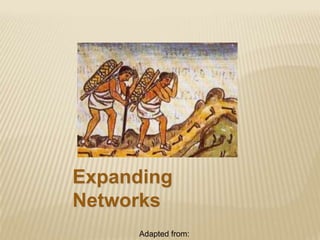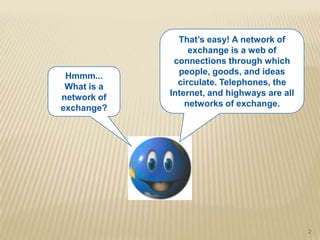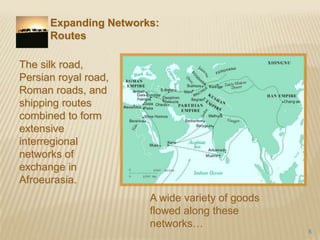Expanding networks
- 1. Expanding Networks Adapted from:
- 2. That’s easy! A network of exchange is a web of connections through which Hmmm... people, goods, and ideas What is a circulate. Telephones, the network of Internet, and highways are all exchange? networks of exchange. 2
- 3. Expanding Networks Routes Around 300 BCE to 300 CE, merchants, shippers, sea captains, and empire-builders extended and strengthened trade routes across Afroeurasia and the Americas. Empires Empires required networks of military and political communication. These networks encouraged interaction of many kinds over long distances. Writing With the appearance of alphabetic writing systems in Afroeurasia, people could communicate faster and easier than ever before. Religions The appearance of world religions— Hinduism, Judaism, Buddhism, and Christianity—stimulated cultural interchange across political and cultural boundaries. 3
- 4. Expanding Networks: Routes In the Americas... The Olmec of Mexico developed extensive trade networks that extended hundreds of miles from Olmec territory. They imported jade and other raw materials for their crafts. Their exports included pottery and sculpture. The Tiwanakans in what is today Bolivia also began to build trade routes during Big Era Four. Llama caravans brought produce, wood, metals, and fish from outlying villages to the city of Tiwanaku. 4
- 5. Expanding Networks: Routes The silk road, Persian royal road, Roman roads, and shipping routes combined to form extensive interregional networks of exchange in Afroeurasia. A wide variety of goods flowed along these networks… 5
- 6. Expanding Networks: On the map are some of the Routes goods traded along the Afroeurasian networks. 6
- 7. Expanding Networks: Routes A number of large states, or empires, appeared in Big Era Four. Empire-builders had to move troops and supplies, dispatch messages, gather intelligence, and collect taxes. These tasks required good systems of communication and transport by land and sea. These systems were created mainly to serve the empire’s government and army. But they also served as highways of commerce, cultural exchange, and migration. An empire is a state that unites many territories and diverse peoples under one ruler or government. 7
- 8. Expanding Networks: Routes Roman Roads The Romans built an extensive network of roads. Over 50,000 miles of paved roads, tracks, and trails radiated from the Forum in the center of Rome to all parts of the empire. 8
- 9. Expanding Networks: Routes Though built primarily to speed troops and supplies, Roman roads were used for commercial purposes, too. Goods were shipped to distant provinces and beyond. Constructed by skilled engineers, the roads were strong enough to support half-ton wagons and wide enough to allow two-way traffic. 9
- 10. Expanding Networks: Routes The Silk Roads was a network of roads, tracks, and trails ran across Inner Eurasia. Most of this region is part of the Great Arid Zone, the belt of dry country that extends across Afroeurasia. Inner Eurasia 10
- 11. Expanding Networks: Routes Inner Eurasia is a region of grassy steppes, rugged mountains, and forbidding deserts. This terrain is hard to cross. Despite these harsh conditions, humans have been carrying goods, ideas, and technologies along the Silk Roads of Inner Eurasia for millennia. Inner Eurasia 1997, Encyclopedia Britannica Inc 11
- 12. Expanding Networks: Routes Domestication of the horse, ox, and camel made humans more mobile. About 3000 BCE, people in the steppes of Inner Eurasia began to take up pastoralism. Because they moved with their herds, they typically did not grow crops. Instead, they traded with farmers and city-dwellers for food and other goods. By 1000 BCE, pastoralists controlled networks of exchange throughout Inner Eurasia . 12
- 13. Expanding Networks: Routes Between 300 BCE and 300 CE, long periods of stability and prosperity in states throughout Afroeurasia stimulated interest in long distance trade. Intercontinental communication and the exchange of goods, became regular, organized, and protected by large empires. The Silk Roads carried shipments of Chinese silk but also many other goods. 13
- 14. Expanding Networks: Routes On the Silk Roads, goods changed hands many times. Parthians, Indians, Kushans, Uigurs, and others acted as middlemen, selling and bartering goods, and taking profits. Caravans passing west carried silk, porcelain, jade, bronze, and spices. Those traveling east shipped gold and silver coins, ivory, gemstones, glassware, and carpets. 14
- 15. Expanding Networks: Routes Roman Ship Sea routes ran down the Red Sea and Persian Gulf, across the Arabian Sea and Bay of Bengal, and through Indian the Straits of Malacca to the Ship South China Sea. These sea lanes often linked up with overland routes, facilitating travel, trade, and Chinese the exchange of ideas Ship across Afroeurasia. 15
- 16. Expanding Networks: Empires Empires had formed in Afroeurasia as early as Big Era Three. Although many claimed vast territories, most did not survive for long. In the 4th century BCE, Alexander the Great amassed an empire that stretched from Greece to India. Upon his death, however, the empire fragmented. The later centuries of Big Era Four saw the rise of new empires that both dominated huge expanses of land and remained unified for a long time. The Largest of these were the Han and Roman empires. 16
- 17. Large Empires of Afroeurasia 500 BCE - 500 CE Rome Byzantium Kushana Xiongnu Parthian/ Sassanid Han Maurya/ Gupta Kush Axum 17
- 18. Expanding Networks: Writing Cool! • Alphabetic writing systems appeared in the later second millennium BCE. These systems used a small number of symbols, or letters, to represent sounds. • Letters could be arranged in countless ways to form words. • The Phoenicians were among the first to devise an alphabet. • Because they were sailors and merchants, the idea of alphabetic writing spread wherever the Phoenicians traveled. • During the first millennium BCE alphabetic writing spread from the Mediterranean region to India. 18
- 19. Expanding Networks: What is a world religion? It’s a belief system that Religions embraces people of differing languages and cultural traditions. Religions that spread during Big Era Four were: Hinduism Judaism Buddhism Christianity 19
- 20. Growth of World Religions In Big Era Four Hinduism From lst millennium BCE Buddhism From 5th century BCE Christianity From 1st century CE Judaism Communities scattered widely in Southwest Asia, Northern Africa, and Europe, especially from the first century CE. Outline Map: Microsoft Encarta Reference Library 2002 20
- 21. Expanding Networks: Religions When people carried a new religion from place to place, they also often took along A writing system (This was useful in teaching holy scripture.) Trade goods (Religion was a basis of trust among merchants.) Art styles (Religious ideas were often expressed in painting, sculpture, and architecture.) 21
- 22. So, what have we learned about two key developments of this era? Population growth and networks 22
- 23. Population growth in Big Era Four was linked to the expansion of agriculture. Increases in population density and job specialization in farming communities led to the creation of more and larger cities. Population Growth Expanded networks of exchange allowed people, goods, and ideas to move thousands of miles. The development of alphabetic writing systems speeded up the transfer of information. Also, people who met, shared ideas, and conducted business with one another helped spread new world religions across Expanding Networks of Exchange Afroeurasia. 23
- 24. So many developments in Big Era Four! Hmmm… I wonder what will happen next. Stay tuned for Big Era Five! 24
























